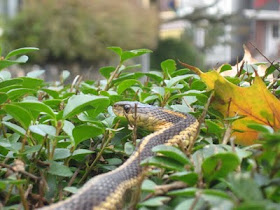 A garter snake on top of our hedge this past September. The garter snake is the Commonwealth of Massachusetts' official reptile, and serves an important function in the eco-system.
A garter snake on top of our hedge this past September. The garter snake is the Commonwealth of Massachusetts' official reptile, and serves an important function in the eco-system. On the night of March 17 I had a very vivid dream. I was walking up the path to our house, and noticed three big garter snakes emerging from the dirt in our yard. This dream made me very happy.
The next day I realized I had dreamed about the snakes on St. Patrick's Day. According to legend, Patrick drove all the serpents out of Ireland. I guess he sent them some to New England, because in addition to the dream snakes I saw my first physical garter snake today in the park. He was very cute! It's been unseasonably warm, so I think he woke up early this year.
I've posted about snake lore a few times in the past, but there's just so much of it. Our cultural ancestor in New England were fascinated by snakes, and obviously feared them and also respected their natural (and supernatural?) power. Here are a few serpentine tidbits to start your spring right:
- New England used to be home to many, many rattlesnakes. I was going to say "infested with rattlesnakes", but that sounds too harsh. In the Boston area, Charlestown was notorious for having a lot of rattlers. For example, in 1630 Governor Winthrop decided to move the colony's capitol from Charlestown to the Shawmut peninsula (now Boston) because it was free from "the three great annoyances of wolves, rattlesnakes and mosquitoes." (We lived in Charlestown in the 1990s in a house with old window screens - the mosquitoes were still there.) John Josselyn reported seeing a rattle snake as thick as a man's leg eat a live chicken outside a tavern in 1674, but this may be an exaggeration.
- By the 1820s, the rattlesnakes had moved to Malden, where a man named John Elisha claimed he could tame them through magical means.
- Some African slaves believed rattlesnake buttons, or pieces of the rattle, could ward off tuberculosis. A slave in Suffield, Connecticut named Titus Kent wore four rattlesnake buttons over his lungs for this purpose. "These he considered a sovereign remedy for consumption, and of course valued them highly, as more of his best friends had died of that dreaded disease." Titus lived a long life, and didn't die of consumption.
- There is a reputed connection between snakes and the weather. Nineteenth century Yankee farmers said if you hang up a dead snake, it will rain. If you bury it, the weather will be fair. The Penobscot of northern New England thought that the thunder spirits, who were seen as either giant birds or superhuman warriors, waged a perpetual battle against turtles and snakes, their ancient enemies.
- The Penobscot also advised against telling legends in the summer. The reason? If a snake overheard and was offended by the story, it would bite the story-teller.
On that note, I'll stop telling stories about snakes. Snakes deserve our love and respect, so please don't kill them!
My sources for all this snake mania were Thomas Palmer's fantastic Landscape with Reptile, the Dublin Seminar's Wonders of the Invisible World, 1600- 1900, Johnson's What They Say in New England, and Frank Speck's article "Penobscot Tales and Religious Beliefs."

Thanks for sharing more Native American lore, I love it!
ReplyDelete